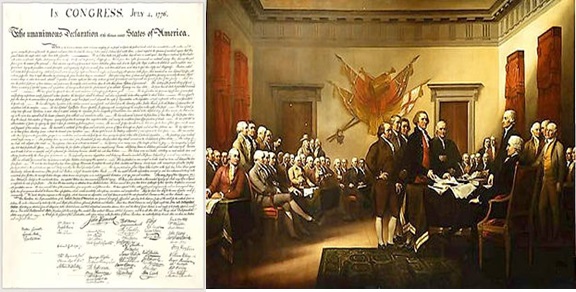Amb. Henry F. Cooper, Chairman . . . Lt. Gen. Daniel Graham, Founder
High Frontier . . Building Truly Effective Defenses . . . Reagan’s Vision Lives!
E-Mail Message 130702
Remember How, When and Why We Began . . .
By Ambassador Henry F. Cooper
July 2, 2013
John Adams thought July 2nd would be a Grand Holiday for the ages! He was right about there being a Holiday for the ages to celebrate the Declaration of Independence and the birth of a great nation—but he was a couple of days off on the date. And Benjamin Franklin’s challenge some 11-plus years later, after also signing the Constitution, is still urgently pressing as we celebrate this Fourth and those who founded these United States, and we are still struggling with the forces of tyranny… Stay tuned.
. . .
In a letter dated July 2, 1776 to his wife Abigail, John Adams wrote: “The Second Day of July 1776, will be the most memorable Epocha, in the History of America.”
Adams’ prediction came as the result of the July 2nd motion for independence being approved by the Second Continental Congress, then having met in Philadelphia since May 10th. This motion and the subsequent vote of the representatives of the 13 original states officially separated the thirteen American colonies from Great Britain. This was over a year after the American Revolution actually began in April 1775—notably at Lexington and Concord, not far from Adam’s home and farm in Braintree/Quincy, Massachusetts.
A confident and euphoric Adams declared: “I am apt to believe that it will be celebrated, by succeeding Generations, as the great anniversary Festival. It ought to be commemorated, as the Day of Deliverance by solemn Acts of Devotion to God Almighty. It ought to be solemnized with Pomp and Parade, with Shews, Games, Sports, Guns, Bells, Bonfires and Illuminations from one End of this Continent to the other from this Time forward forever more.”
Adams would be two days off in his prediction, however. On July 4th, Adams joined with the rest of his colleagues in approving the Declaration of Independence, a document that eloquently articulated the reasons why the colonies had separated from the British Empire. This approval—on July 4th —would go down in history as the “memorable Epocha.”
Prints of this approved version of the Declaration carry the July 4, 1776 date were prepared by John Dunlap, the official printer for the Continental Congress, and widely distributed on July 5. The text of these so-called “Dunlap Broadsides” was followed by the words “Signed by Order and in Behalf of the Congress, John Hancock, President; Attest. Charles Thomson, Secretary.” Click here to review the sequence of events in drafting and signing the Declaration of Independence.
The best known and final version, in excellent cursive penmanship and dated July 4, 1776, was actually signed on August 2nd by most of the representatives to the Continental Congress, and eventually by all 56, who represented America’s 13 original states. It explained, like its predecessor versions, their decision to King George II and the rest of the world.
The Declaration’s preamble included a most memorable sentence that I and all of my generation memorized in grade school, declaring:
“We hold these truths to be self evident, that all men are created equal, that they are endowed by their Creator with certain unalienable Rights, that among these are Life, Liberty and the pursuit of Happiness.”
Subsequent paragraphs listed indictments and a denunciation and concluded with another memorable paragraph:
We, therefore, the Representatives of the united States of America, in General Congress, Assembled, appealing to the Supreme Judge of the world for the rectitude of our intentions, do, in the Name, and by Authority of the good People of these Colonies, solemnly publish and declare, That these united Colonies are, and of Right ought to be Free and Independent States; that they are Absolved from all Allegiance to the British Crown, and that all political connection between them and the State of Great Britain, is and ought to be totally dissolved; and that as Free and Independent States, they have full Power to levy War, conclude Peace, contract Alliances, establish Commerce, and to do all other Acts and Things which Independent States may of right do. And for the support of this Declaration, with a firm reliance on the protection of divine Providence, we mutually pledge to each other our Lives, our Fortunes and our sacred Honor.
This was a formal, unilateral declaration of our Union, whether July 2nd or 4th of 1776, even though we had been at war with Great Britain for over a year for the causes boldly embodied in the Declaration—a war that was to continue for another 6 years until Cornwallis surrendered at Yorktown in 1782 and the new nation’s status was formalized by the 1783 Treaty of Paris that recognized internationally the sovereignty of the United States of America.
Still, it took another four-plus years of being governed under the relatively loose and ineffective U.S. Articles of Confederation (1781-89), until on September 17, 1787, the U.S. Constitution was signed, also in Philadelphia’s Independence Hall, establishing ground rules by how a far more effective Federal Government would protect the liberty of “We the People.” As Benjamin Franklin was leaving that signing he was asked by a lady, “Well, Doctor, what have we got—a Republic or a Monarchy?” to which he famously replied, “A Republic if you can keep it.”
But this did not settle the actual formation of this new government—for the peoples of the then original thirteen states. Subsequently, the Constitution was ratified by nine states, and on June 22, 1788 it became the supreme “Law of the Land.” George Washington was sworn in on March 4, 1789 as the first U.S. Congress met in New York City. Vermont became the last of the 13 states to ratify the Constitution on January 10, 1791. Click here for the ratification timeline.
The all important Bill of Rights—even today, insisted upon by Thomas Jefferson and drafted by James Madison, were introduced in the House of Representatives in 1789. Ten of Madison’s proposed twelve amendments, intended to limit the power of government to protect the natural rights of liberty and property, became the first ten Amendments to the Constitution on December 17, 1791, after ratification of three quarters of the states.
As we plan to enjoy the festivities of this Fourth, we should ponder again Franklin’s question and answer . . . this serious exchange is as pertinent to us today as it was to the signatories of the Constitution and – a dozen or so years earlier – the Declaration of Independence, which focused on the tyranny from which they then sought to be free. Can we keep the “Republic” our founder’s gave us? There are reasons for doubt, and so we still need Patriots who will continue the fight for Liberty.
We should consider the issues of our day and the bloated legacy of the limited federal government our founders gave us; and seek to remain true to our founding documents and the Patriots who mutually pledged their lives, their fortunes, and their sacred honor to give us this great nation. The Liberty of our posterity demands no less of us. As my hero and once big boss, Ronald Reagan, said:
Freedom is never more than one generation away from extinction. We didn’t pass it to our children in the bloodstream. It must be fought for, protected, and handed on for them to do the same, or one day we will spend our sunset years telling our children and our children’s children what it was once like in the United States where men were free.
Our leaders are still sworn to support and defend the Constitution, though sometimes one wonders whether they truly intend to live up to that oath. The Founders intended the Constitution to be the foundation of our unalienable Rights, among which are “Life, Liberty and the pursuit of Happiness.” And “we the people,” now from 50 states rather than just 13, must hold our leaders, each and every one, accountable for their respective oaths of office, which vary in detail but not in intent.
. . . .
We at High Frontier will continue to inform the powers that be of existential threats to this great nation—as we have discussed in our emails for many months—and to urge them to “provide for the common defense” as charged by the Constitution they are sworn to uphold. Hopefully, key federal authorities and members of congress will soon begin to deal more effectively with this existential threat, as we discussed last Friday.
We will also be taking the message to grass roots America. Our local and state authorities need to understand these issues and what they might do if their federal representatives continue to fail “to provide for the common defense.”
And what can you do?
Join us at High Frontier in seeking to alert the public and your local and state authorities to the existential threats posed by both man-made and natural EMP events—and what can be done about these threats.
We can use your help in spreading this information to the grass roots and to encourage all “powers that be” to provide for the common defense as they are sworn to do. Will you do your part?
Begin by passing this message to your friends and suggest they visit our webpage, www.highfrontier.org for more information. Also, please encourage your sphere of influence to sign up for our weekly e-newsletter!
Please click here to read Past Weekly Udpates!
Please click here to read past Flash Messages!
Please help High Frontier continue this important and timely work!
Be sure to follow us on our Social Sites!
If you found this letter via our Social Sites, and you would like to subscribe, click below!







